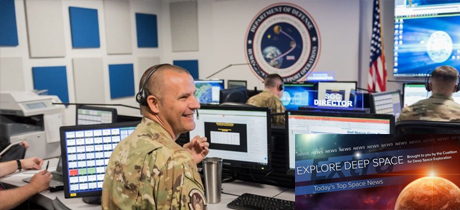In Today’s Deep Space Extra… In a move to ensure a continuous U.S. presence on the International Space Station (ISS), NASA announced the purchase of a seat aboard a three person Russian Soyuz rocket planned for launch in October. Elements responsible for U.S. national security are rallying to protect the economic health of the nation’s space industrial base.
Human Space Exploration
NASA signs deal for additional Soyuz seat
Coalition Member in the News – Boeing
SpaceNews.com (5/12): NASA will pay Russia just over $90 million to launch an astronaut to the International Space Station (ISS) in October to ensure a continued U.S. presence on the 15 nation orbiting science lab. Though continuously occupied since early November 2000, the number of crew dropped from the typical six to seven persons to three earlier this year due to delays experienced by NASA’s Commercial Crew Program partners. NASA hopes the Commercial Crew Program can re-initiate the regular transportation of astronauts once provided by NASA’s space shuttle this year. SpaceX and Boeing are striving to complete certification, potentially by year’s end.
Dragon solar array concerns driving duration of first crewed test flight
Spaceflightnow.com (5/12): NASA astronauts Bob Behnken and Doug Hurley are in line to liftoff May 27 from the Kennedy Space Center (KSC), the first launch from U.S. soil since the agency’s space shuttle fleet was retired in July 2011. Their SpaceX Crew Dragon Demo-2 mission is to deliver them to the ISS for a stay that could last from one to four months. SpaceX hopes to complete certification under NASA’s Commercial Crew Program with Demo-2 to begin making make regularly scheduled round trips to the ISS. Demo-2’s duration will depend on how well the Crew Dragon’s electricity generating solar panels withstand the rigors of the space environment.
Space Force troops preparing for possibility of having to rescue NASA astronauts
SpaceNews.com (5/12): When the NASA/SpaceX Demo-2 mission lifts off from NASA’s Kennedy Space Center (KSC) with NASA astronauts Bob Behnken and Doug Hurley on lengthy test flight to the ISS, Task Force 45, a unit of the new U.S. Space Force based at Patrick Air Force Base, Florida, will be on alert to lead a rescue if necessary. The launch planned for May 27 is to mark the first launch of astronauts from the U.S. since NASA’s shuttle fleet was retired in July 2011. The 150 member task force includes rescue divers, pilots, communications and medical experts.
These lava tubes could be the safest place for explorers to live on Mars
Space.com (5/12): Absent a magnetic field, Mar’s is a haven for space radiation, a hazard to human explorers. A series of lava tubes in the Hellas Planitia region of the Red Planet, an impact basin created by an ancient meteor impact may, however, provide a safe haven for future human explorers, according to a recent research effort.
UAE to select next astronauts in January
SpaceNews.com (5/11): The United Arab Emirates (UAE) plans to double the size of its astronaut corps, from two to four members by early next year, selecting from a collection of more than 4,000 applicants. UAE astronauts Hazza Al Mansoor visited the ISS briefly last year.
Space Science
The Space Station’s coolest experiment gets astronaut-assisted upgrade
NASA Jet Propulsion Laboratory (5/12): NASA’s Cold Atom Lab hosts a unique fundamental physics experiment unfolding aboard the ISS. Astronauts Christina Koch and Jessica Meir, now back on Earth, recently participated in a major upgrade of the experiment facility developed to study how atoms behave at the coldest possible temperatures.
NASA is going to try manufacturing a telescope mirror in space
Universe Today (5/12): NASA backed researchers believe Atomic Layer Deposition, a chemical atomic layer by layer manufacturing process, may be the key to fabricating large, powerful observatories in space as an alternative to assembling them on Earth and launching them.
Other News
National security space conference to propose plan to boost industrial base
SpaceNews.com (5/11): Last week’s four day “State of the Space Industrial Base 2020” program led by the Defense Innovation Unit, the Air Force Research Laboratory and the U.S. Space Force and organized by the nonprofit advocacy group NewSpace New Mexico assessed challenges to long term U.S. military and economic leadership in space posed by the COVID-19 pandemic. A report based on discussions and planned for release in June will urge a “whole of government” response to stimulate private and public sector investments in space and STEM education.
A bankrupt OneWeb could get some help from the Defense Department
Defense News (5/12): OneWeb, which recently filed for bankruptcy, and other space startups facing financial difficulties in response to the coronavirus pandemic could get help from the Defense Department. OneWeb’s efforts to expand internet communications to the far northern latitudes is a capability the new U.S. Space Force is in need of. “I will say with respect to OneWeb specifically and others, we continue to work,” Lt. Gen. David Thompson, vice commander of Space Force Headquarters, said during a Mitchell Institute for Aerospace Studies event held Tuesday.
Large chunks of a Chinese rocket missed New York City by about 15 minutes
Ars Technica (5/12): Last week, China sent a future human spacecraft prototype into Earth orbit on a powerful Long March 5B rocket. The large rocket’s massive core stage remained in orbit with a low point that triggered an atmospheric re-entry over the Atlantic Ocean on Monday at 11:33 a.m., EDT, according to the U.S. Space Force. Had the re-entry occurred 15 to 20 minutes earlier, debris from the breakup of the core stage as it re-entered may have fallen over the New York area.

